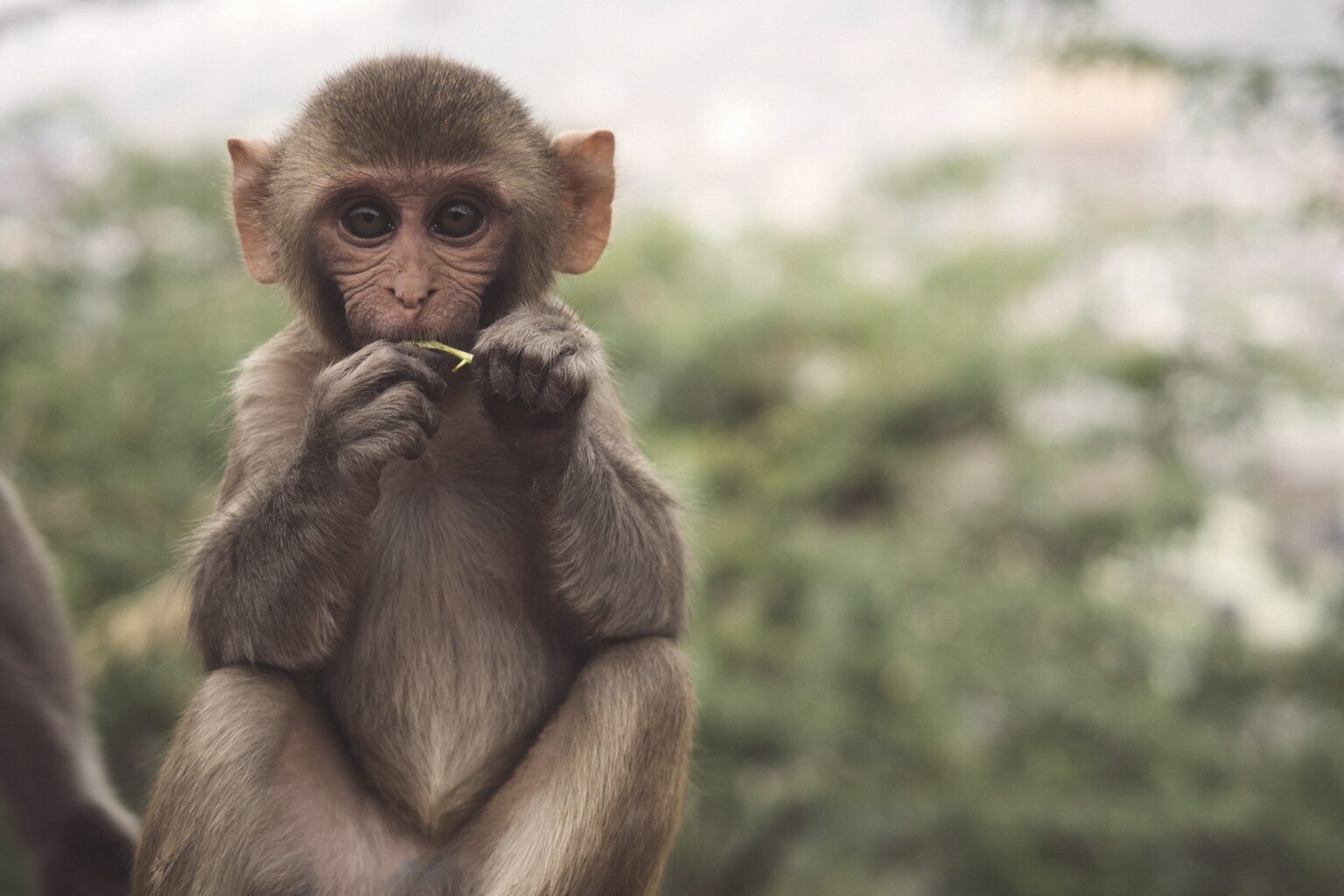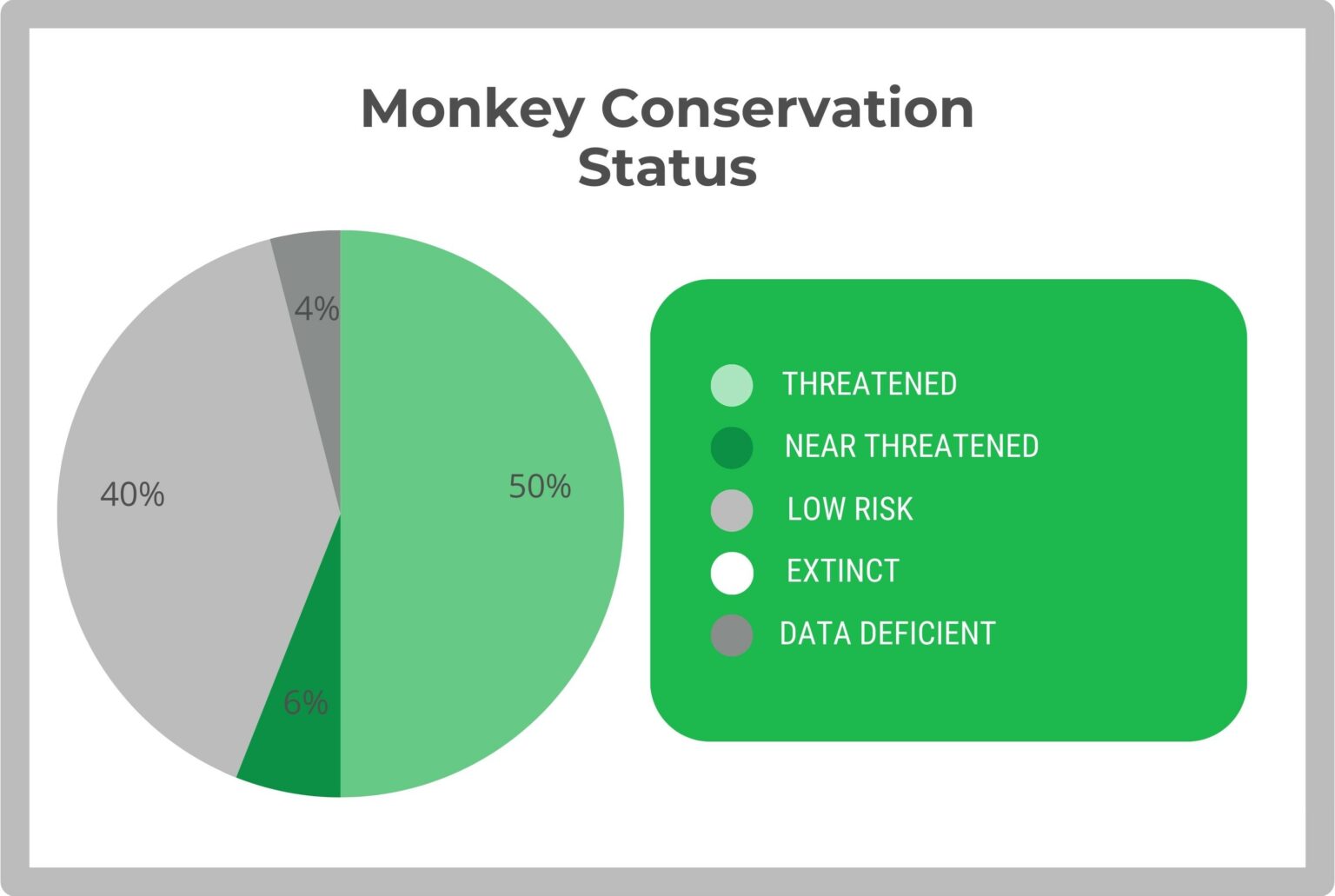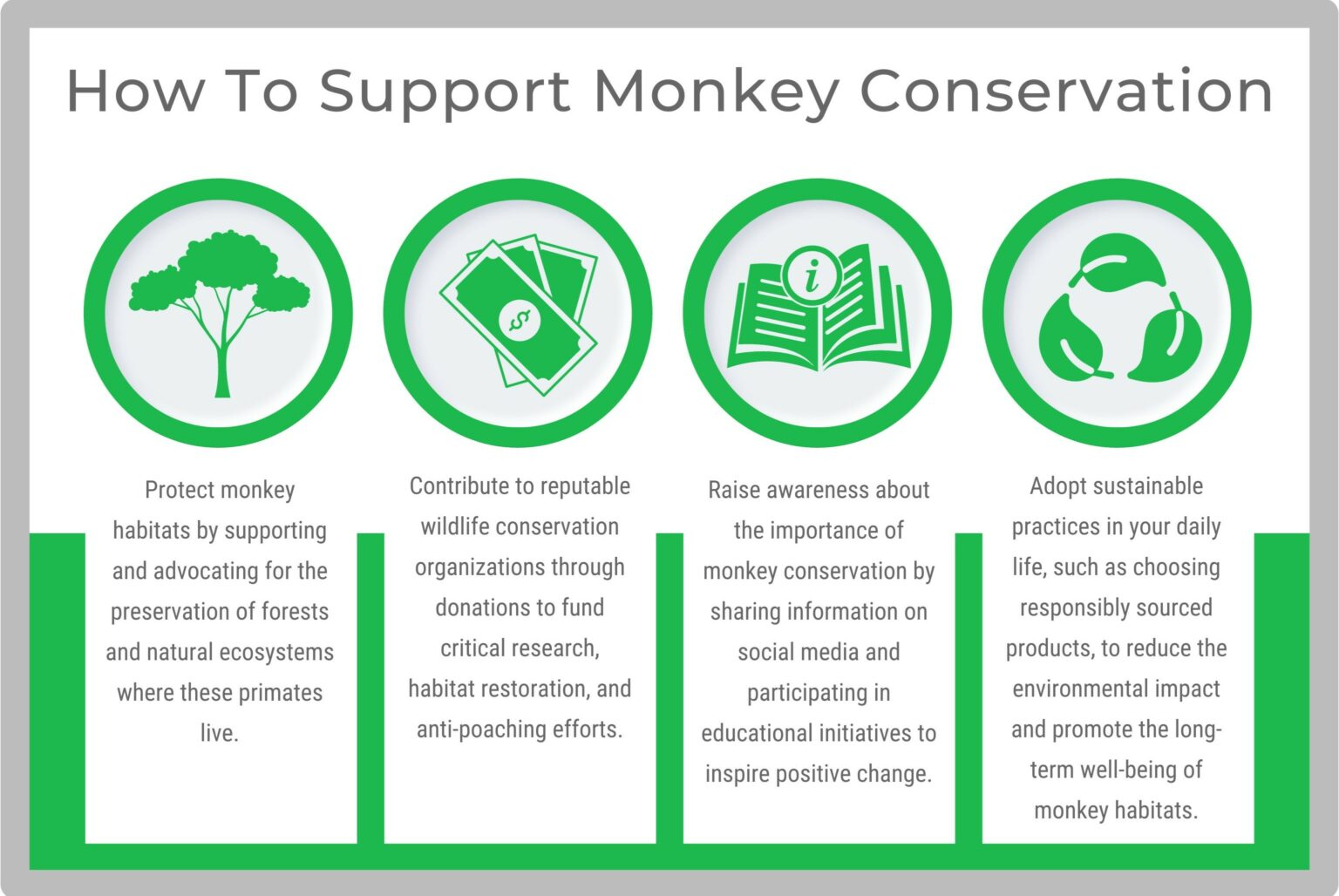Monkey Day – Facts, Statistics, and Expert Insights
In celebration of Monkey Day on December 14, we have put together a list of the most important facts and statistics about primates. You will also find a list of events and awareness campaigns that you can get involved with.

Key Primate Facts
- There are 505 nonhuman primate species living in the wilds of 90 countries across the globe.
- The monkey population comprises around 260 distinct species, distributed across various regions.
- 60% of the wild primate species are on course to die out, and 75% are already in steady decline.
- Some primates are acknowledged for their intelligence, possessing an active IQ comparable to that of a 3-year-old toddler.
- Just four countries—Brazil, Madagascar, Indonesia, and the Democratic Republic of the Congo (DRC)—harbor 65% of all primate species.
- The pygmy marmoset holds the title of the world’s smallest primate, with a diminutive body length of approximately 5 inches (12 cm) and a tail measuring about 7 inches (17 cm).
- Patas monkeys claim the status of the fastest primates, achieving speeds of up to 35 mph—equivalent to the pace of a racehorse. Their impressive acceleration can reach from zero to 33 miles per hour in just three seconds.
- Social by nature, most primates live in groups known as troops, ranging from small gatherings to extensive assemblies. The largest monkey troops globally, composed of Ethiopian geladas, consist of 350 to 650 individuals.
- Monkey lifespans exhibit significant diversity, with baboons potentially living 20 to 40 years, while pygmy marmosets typically have a lifespan of 10 to 12 years.
- The oldest chimpanzee ever recorded was named Little Mama – she lived to be 79 years old.
- Monkeys can indulge in sleep for up to 9.5 hours, a duration exceeding the typical 8-hour sleep cycle for humans.
Sources: NRDC, Live Science, National Geographic, World Animal Protection,
Celebrating Monkey Day is a great way to create awareness about primates across the globe! Lemurs are prosimians- a unique group of primates found only on the island of Madagascar! Unfortunately, 98% of all species are threatened with extinction- making them the most threatened group of mammals on our planet. The number threat to the 112 different species of lemurs is habitat loss due to the cultural practices of slash and burn agriculture. – Susie Louis, Conservation Fusion
Primate Population Statistics
| Subspecies | Population (estimate) | Range |
| Muller’s Bornean Gibbon | 250,000 – 375,000 | Borneo (Indonesia and Malaysia) |
| Gelada | 200,000 | Ethiopia |
| Common Chimpanzee | 172,700 – 299,700 | Africa (various regions) |
| Western Gorilla | 150,000-200,000 | Central and West Africa |
| Bornean Orangutan | 45,000-69,000 | Borneo (Indonesia and Malaysia) |
| Mentawai Langur | 36,000 | Mentawai Islands (Indonesia) |
| Bonobo | 29,500-50,000 | Democratic Republic of the Congo |
| Kloss’s Gibbon | 20,000-50,000 | Sumatra (Indonesia) |
| Red-eared Guenon | 20,000 | West Africa |
| Nilgiri Langur | 20,000 | Western Ghats, India |
| Siberut macaque | 17,000-30,000 | Siberut Island (Indonesia) |
| Northern red colobus | 15,400 | Africa (various regions) |
| Barbary macaque | 15,000 | North Africa, Gibraltar |
| Roosmalens’ Dwarf Marmoset | 10,000 | Amazon Rainforest (Brazil) |
| Natuna Island Surili | 10,000 | Natuna Islands (Indonesia) |
| Madame Berthe’s Mouse Lemur | 8,000 | Madagascar |
| Sumatran Orangutan | 7,300 | Sumatra (Indonesia) |
| Gray-headed Lemur | 7,265 | Madagascar |
| Pig-tailed lemur | 6,700-17,300 | Madagascar |
| Golden-headed Lion Tamarin | 6,000-15,000 | Brazil (Atlantic Forest) |
| Golden-crowned sifaka | 6,000-10,000 | Madagascar |
| Cottontop Tamarin | 6,000 | Colombia, Venezuela |
| Golden bamboo lemur | 5,916 | Madagascar |
| Eastern gorilla | 5,880 | Central and East Africa |
Source: World Atlas
Threats to Primates
“Many primate species are endangered and threatened in the wild, but captive monkey welfare is particularly threatened by their rampant exploitation as exotic pets. Primates need the company of their own kind, can never be domesticated, can never have their needs met in a human home, and naturally become aggressive towards humans as they grow. Recognizing and not ignoring the complex needs of these unique species is of vital importance on Monkey Day, and every day! For those individuals who have been taken from the wild or who have never lived in the wild, placement in a reputable, accredited sanctuary is the only way monkeys can thrive and enjoy a, enriched, species-appropriate life.” – Erika Fleury, North American Primate Sanctuary Alliance
- Habitat Loss and Fragmentation: Deforestation and habitat destruction due to agriculture, logging, and urbanization can lead to the loss of the primates’ natural habitats.
- Experimentation: Globally, an estimated 100,000 to 200,000 primates are used in research every year.
- Illegal Wildlife Trade: Monkeys are often captured and traded for the exotic pet market or for their body parts, which contributes to the decline of wild populations.
- Hunting and Poaching: Some primate species are hunted for their meat or body parts, either for local consumption or for trade in traditional medicine.
- Climate Change: Changes in climate patterns can affect the availability of food sources and disrupt the ecosystems where primates live.
- Disease: The transmission of diseases from humans or other animals can pose a significant threat to primate populations, especially in areas where human and other primate habitats overlap.
“Primates are intelligent and live complex social lives. They require specific habitats to survive which cater for their behaviour and nutritional needs. The threats that primates face in the wild often mean they end up in human care, for example, the illegal pet trade, loss of habitat, and human-wildlife conflict. When primates do come into captivity, they need specialist care and specific environments. Wild Welfare has been working with zoos and sanctuaries for over 10 years, delivering training and creating resources in several languages to animal care staff to ensure animals can experience good welfare and are able to thrive. This capacity building allows for long-term care to be given to the many thousands of primates and other animals in captivity around the world.” – Simon Marsh, Wild Welfare

- Electrocution and Infrastructure Development: Power lines and other infrastructure can pose risks to primates, leading to injuries or fatalities through electrocution or collisions.
- Pesticide and Chemical Exposure: Agricultural practices and the use of pesticides can contaminate the primates’ habitats, affecting their health and reproductive capabilities.
- Invasive Species: The introduction of non-native species to certain areas can disrupt ecosystems and negatively impact primate populations by competing for resources or introducing new diseases.
- Human-Wildlife Conflict: As humans encroach upon natural habitats, conflicts may arise between primates and local communities due to crop raiding or perceived threats to human safety.
- Lack of Conservation Measures: Insufficient conservation efforts, laws, and regulations can contribute to the ongoing decline of primate populations, leaving them vulnerable to various threats.
“Monkey Day is a fun way to raise awareness of primates – a fascinating group of animals that includes monkeys, lemurs, apes, and humans. Sadly, many of our primate relatives are endangered due to poaching, the pet trade, and habitat loss.” – Karen Kemp, Friends of Bonobos
How You Can Help
- Support Conservation Organizations: Contribute to reputable organizations dedicated to primate conservation, such as the World Wildlife Fund (WWF), Conservation International, and the Jane Goodall Institute. Your donations can fund critical research, habitat protection, and community engagement efforts.
- Raise Awareness: Share information about the threats facing primates and their importance in ecosystems. Use social media platforms to spread awareness about conservation issues, and encourage others to join the cause.
- Choose Sustainable Products: Make environmentally conscious choices when purchasing products, particularly those made from or containing materials that contribute to deforestation. Look for sustainable and certified products that support responsible sourcing.
- Respect Wildlife Sanctuaries and Protected Areas: If you visit areas where primates live, such as wildlife sanctuaries or protected natural habitats, follow ethical wildlife viewing guidelines. Keep a safe distance, avoid feeding wildlife, and adhere to any regulations in place to protect the animals and their environments.
- Volunteer for Conservation Projects: Explore opportunities to volunteer with local and international conservation projects. Many organizations and initiatives welcome volunteers to contribute their time and skills to research, habitat restoration, and community outreach programs.
- Educate Others: Share your knowledge about primate conservation with friends, family, and colleagues. Engage in conversations about the importance of protecting wildlife and their habitats, emphasizing the interconnectedness of ecosystems.
Organisations to Support
Friends of Bonobos
“Bonobos are one of the 4 nonhuman great apes, and their DNA is 98.7% the same as ours. But they are unlike any other ape! They are matriarchal and much less violent than male-dominated chimpanzees. Bonobos welcome newcomers and share their food. They also live only in one place – the Democratic Republic of Congo. Another fun fact: Bonobos have a “day” too – World Bonobo Day is February 14!” – Karen Kemp, Director of Communications and Media Relations
“At Friends of Bonobos, we’re doing everything we can to save bonobos from extinction. We rescue orphaned bonobos from poachers, give them sanctuary and loving care, and when possible, return them to the wild in a protected forest. Our educational programs and community development projects are helping to secure the future of both bonobos and their habitat. Primate lovers can join the effort by donating to support our work. They also can make a difference by becoming an advocate for apes and monkeys. For example, don’t share or engage with any social media content that shows monkeys or apes held as pets or being exploited for human amusement. Apes and monkeys belong in the forests, with their own families.” – Karen Kemp, Director of Communications and Media Relations
Born Free
The North American Primate Sanctuary Alliance
The North American Primate Sanctuary Alliance (NAPSA) is a coalition of the leading primate sanctuaries on the continent who care for close to 800 monkeys and apes from biomedical research, entertainment, and private ownership. NAPSA unites the primate sanctuary community, builds capacity to provide sanctuary for captive nonhuman primates, and advocates to eliminate primate exploitation. – Erika Fleury, Director
Conservation Fusion
There is HOPE! Since a majority of people in Madagascar are subsistence farmers- we can introduce new, alternative farming techniques such as using compost and crop rotation. This creates a balance between people and primates- creating a brighter future! Happy Monkey Day from the Conservation Fusion Team! – Susie Louis, Founder & Director
Wild Welfare
“Wild Welfare’s mission is to end the suffering of captive wild animals around the world, by uniting the world’s leading animal welfare organisations and captive wildlife facilities in providing expert, practical and sustainable solutions to improve animal welfare.” – Simon Marsh, Director
